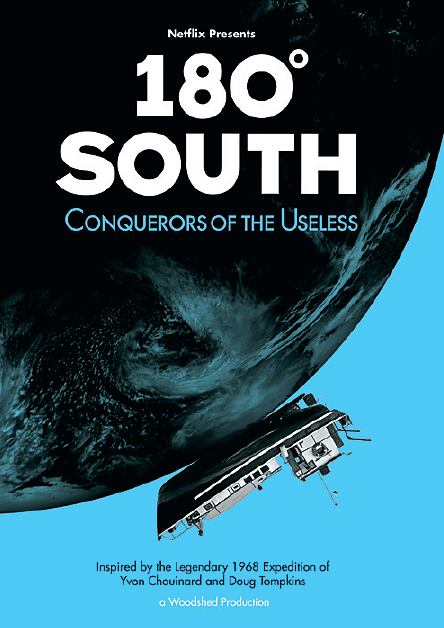180° South: Conquerors of the Useless
18/10/12 14:40 Filed in: Movie Review | kd

1964. His climbing achievements in the Yosemite Valley in the sixties set the tone and basis for what we now know as Modern Rock Climbing. In order to accomplish this feat, Yvon taught himself blacksmithing and used this skill to forge his own climbing tools. Some of the original pitons & anchors that he forged during these days still remain on El Capitan and are in use today. This new business allowed him to supply climbers with safe equipment, as well as fund his future adventuring trips. The company, named Chouinard Equipment, would eventually become the Black Diamond Equipment Company but would also spin off to become another force in the adventure gear business, Patagonia Clothing.
The inspiration of the name and logo for the Patagonia clothing company came during a 6 month trip to Chile that Yvon embarked on in 1968 with a group of friends, among them a young climbing enthusiast and entrepreneur named Douglas Tompkins. Doug was very much like Yvon in the sense that he sought adventure and in order to do so he started an adventure gear business called The North Face in the early sixties that would fund these ventures. The North Face company created tents that were among the first to remove the need of a center pole to support the tent, a design that is now copied in almost all tent designs available today.
It was on this trip in 1968 that Yvon and Doug set out in an old Ford van along the early Pan American highway to Chile in order to explore and climb the untouched wilderness of the Patagonia region. They decided to video tape their climb of Mount Fitzroy and this footage was used to create one of the most popular climbing films ever made, Mountain of Storms. It was this very film that almost forty years later would inspire a kindred spirit named Jeff Johnson to film 180° South, which is a modern day recreation of this trip.
180° South follows Jeff Johnson from his humble beginnings in Danville, CA to present day where he attempts to recreate the trip that Yvon & Doug took in the sixties. The world has changed significantly since then, with the convenience of paved roads and airplanes making a trip to Patagonia accessible to all. However, taking the easy route is the antithesis of what Jeff intends to do in this film. He opts to take the road less traveled and hitch a ride on a sailboat disembarking for Chile from Mexico. This decision almost immediately gives Jeff what he's been searching for as the crew runs into trouble in the rough seas of the Pacific, which forces them to take safe harbor on the Island of Rapa Nui, also known as Easter Island.
The crew eventually makes it to Chile where they meet up with Yvon and Doug, who are aware of Jeff's attempt to recreate their adventure and make themselves available to help the crew in any way they can. In fact, Yvon, now at the age of 73, decides to join the crew on their ascent of Corcovado, a stratovolcano located in Patagonia and his bush knowledge of the region comes in handy as they start their climb into the wilderness.
The remainder of the film follows the crew on the ascent of Corcovado but also diverges to focus on the conservation efforts being championed in Chile by Doug Tompkins. Doug started The Conservation Land Trust in the early nineties, an organization that is focused on protecting the wildlands of Chile and Argentina. We learn of the struggles of the indigenous people of Patagonia and their struggle against government and the industries that are destroying their homeland in the name of progress. We hear the stories of over-fished seas, water pollution and their fight against the government to preserve what has been their livelihood for generations.
Overall, the film delivers heavily for those seeking a classic adventure film in the vein of Mountain of Storms. Beautifully shot and set to a fantastic soundtrack, you'd be hard pressed to not walk away from this film with a sense of awe and admiration for those that travel off the beaten path. The underlying message of conservation comes through loud and clear; it is our responsibility as humans to preserve the roads less traveled by for those that will seek adventure after we are long gone.
blog comments powered by Disqus
